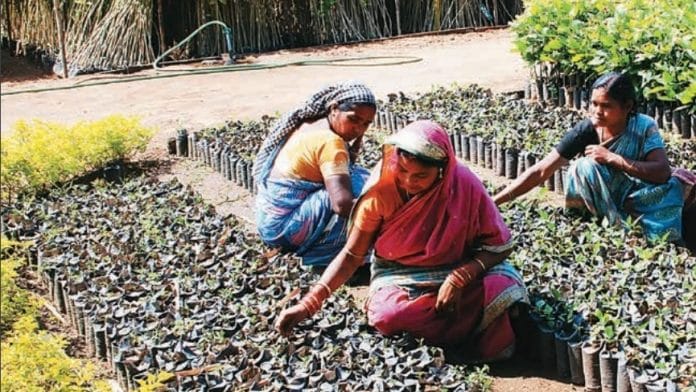New Delhi: Continuing its thrust on pro-poor, pro-rural and pro-marginalised initiatives, the Prime Minister Narendra Modi-led government in its Union Budget laid special emphasis on the welfare of segments like rural India, women as well as Scheduled Castes (SC) and Scheduled Tribes (ST).
“For today’s youth born at the turn of the century, for every member of Scheduled Castes and Scheduled Tribes who seeks a better life, for every woman wishing to stand up and get counted, for every individual from the minority sections of our society — this Budget aims to have your aspirations and hopes addressed,” Finance Minister Nirmala Sitharaman said in her speech in Parliament Saturday.
For the Ministry of Rural Development, the government allocated Rs 1,22,000 crore — a marginal increase from over Rs 1,19,000 crore allocated in FY 2019-20, with a mammoth share, as usual, going to the biggest job guarantee scheme in the country, the Mahatma Gandhi National Rural Employment Guarantee Act (MGNREGA).
The scheme has been allocated Rs 61,500 crore — higher than last year’s Budget estimate, but lower than the revised estimate of Rs 71,000 crore.
The job guarantee scheme got its highest ever allocation of Rs 60,000 crore in the Modi government’s last Budget in its previous term, as well as in last July’s interim budget.
MGNREGA, introduced by the Congress-led UPA government in February 2006, promises a 100-day employment every year to each rural household.
PM Modi had once described MGNREGA as a “living monument of the UPA’s failures”, in the Parliament and yet, the scheme’s allocation has only been increasing under his government.
While activists say the funding does not meet the requirements, the MGNREGA is a demand-driven scheme and the Act mandates the government to provide work accordingly.
Also read: How 45 NGOs and $15 million brought down bonded labour in UP, Bihar & Tamil Nadu
Allocation to signature welfare schemes
The other big-ticket programme of the rural development ministry — rural housing under the Pradhan Mantri Awas Yojana-Grameen or PMAY-G — has got a budgetary allocation of Rs 19,500 crore, as against Rs 19,000 crore last year.
This is a negligible increase, but the scheme’s initial plan had itself laid out the amount that would be needed to meet targets until 2022, which was divided across years.
The PMAY-G is a refurbished version of the Indira Awas Yojana (IAY), which aims to provide “housing for all’’ in rural India by 2022.
Meanwhile, the Pradhan Mantri Gram Sadak Yojana (PMGSY) — the rural roads scheme — has also been allocated Rs 19,500 crore, as against Rs 19,000 core allocated last year.
This is marginally more than last year’s allocation but significantly higher than the revised estimate of Rs 14,000 core.
Besides schemes under the rural ministry, the Modi government’s marquee health insurance scheme under the health ministry is its other big pro-poor step.
The government had announced an outlay of over Rs 62,500 crore for the health sector in the 2019-2020 Budget — the highest in the last two financial years, which has now gone up to Rs 69,000 crore.
Of this, Rs 6,400 crore has been allocated to Pradhan Mantri Jan Arogya Yojana (PMJAY), also known as Ayushman Bharat, the same as in 2019-20.
Ujjwala — a hugely popular scheme to provide LPG connections to poor households — has been allocated Rs 1,118 crore.
The scheme had received an allocation of Rs 2,724 crore in the July Budget, down from the revised estimates of 2018-19 at Rs 3,200 crore.
Funding for marginalised sections
Budget 2020 proposed Rs 53,700 crore for STs, and Rs 85,000 crore for SCs and other backward classes.
For the Ministry of Women and Child Development, Rs 30,000 crore has been allocated, up from Rs 29,000 crore last year, and for the minority affairs ministry, it is Rs 5,000 crore, up from Rs 4,700 crore last year.
Specifically, Sitharaman said the government has earmarked Rs 28,600 crore for women-specific programmes and Rs 35,600 crore for nutrition schemes.
Welfare and pro-rural schemes have been a crucial plank for the Modi government in its first term, and are perceived to have had a dominating role in its convincing return to power in the 2019 Lok Sabha polls.
With inputs from Himani Chandna & Fatima Khan
Also read: Modi wanted to end MGNREGS. Now it’s his only tool to ride through slowdown






